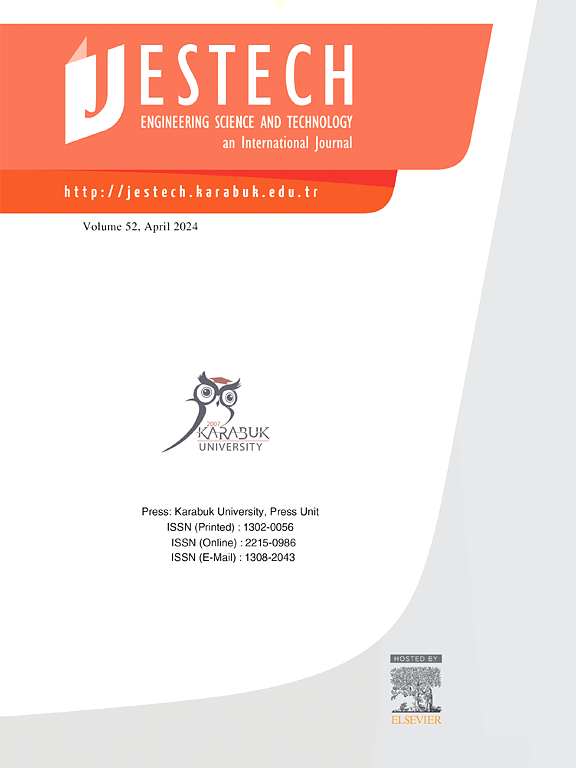Design, fabrication, and performance analysis of a silicon solar cell integrated transparent antenna for wireless communications
IF 5.1
2区 工程技术
Q1 ENGINEERING, MULTIDISCIPLINARY
Engineering Science and Technology-An International Journal-Jestech
Pub Date : 2025-01-01
DOI:10.1016/j.jestch.2024.101915
引用次数: 0
Abstract
The solar cell integrated transparent antenna will serve the purpose of power generation as well as an antenna for satellites and can act as an asset to expand the possibilities of green technology. The goal is to enhance antenna characteristics without hampering solar cell performance. In this work, a super solar integrated optically transparent microstrip patch antenna has been studied using CST Microwave Studio along with Lumerical FDTD and DEVICE solutions. The optically transparent antenna has a Soda-lime glass substrate, with Indium Tin Oxide patch and ground plane. The fabricated antenna is integrated with a 25 40 mm2 thin-film silicon solar cell via epoxy resin. UV–Vis spectroscopy results revealed more than 90% transmissivity over a significant visible wavelength range. It has an operational bandwidth of 80 MHz (@5.48 GHz) and solar simulator results indicate that the photovoltaic performance of the proposed device is similar to that of a standalone solar cell.
无线通信用硅太阳能电池集成透明天线的设计、制造和性能分析
太阳能电池集成透明天线不仅可以用作卫星天线,还可以用作发电用途,可以作为扩大绿色技术可能性的资产。目标是在不影响太阳能电池性能的情况下增强天线特性。在这项工作中,利用CST微波工作室以及Lumerical FDTD和DEVICE解决方案研究了一个超级太阳能集成光学透明微带贴片天线。该光学透明天线具有钠钙玻璃基板,具有氧化铟锡贴片和接地面。该天线通过环氧树脂与25 × 40 mm2薄膜硅太阳能电池集成。紫外-可见光谱结果显示,在显著的可见波长范围内,透射率超过90%。它的工作带宽为80 MHz (@5.48 GHz),太阳能模拟器结果表明,该器件的光伏性能与独立太阳能电池相似。
本文章由计算机程序翻译,如有差异,请以英文原文为准。
求助全文
约1分钟内获得全文
求助全文
来源期刊

Engineering Science and Technology-An International Journal-Jestech
Materials Science-Electronic, Optical and Magnetic Materials
CiteScore
11.20
自引率
3.50%
发文量
153
审稿时长
22 days
期刊介绍:
Engineering Science and Technology, an International Journal (JESTECH) (formerly Technology), a peer-reviewed quarterly engineering journal, publishes both theoretical and experimental high quality papers of permanent interest, not previously published in journals, in the field of engineering and applied science which aims to promote the theory and practice of technology and engineering. In addition to peer-reviewed original research papers, the Editorial Board welcomes original research reports, state-of-the-art reviews and communications in the broadly defined field of engineering science and technology.
The scope of JESTECH includes a wide spectrum of subjects including:
-Electrical/Electronics and Computer Engineering (Biomedical Engineering and Instrumentation; Coding, Cryptography, and Information Protection; Communications, Networks, Mobile Computing and Distributed Systems; Compilers and Operating Systems; Computer Architecture, Parallel Processing, and Dependability; Computer Vision and Robotics; Control Theory; Electromagnetic Waves, Microwave Techniques and Antennas; Embedded Systems; Integrated Circuits, VLSI Design, Testing, and CAD; Microelectromechanical Systems; Microelectronics, and Electronic Devices and Circuits; Power, Energy and Energy Conversion Systems; Signal, Image, and Speech Processing)
-Mechanical and Civil Engineering (Automotive Technologies; Biomechanics; Construction Materials; Design and Manufacturing; Dynamics and Control; Energy Generation, Utilization, Conversion, and Storage; Fluid Mechanics and Hydraulics; Heat and Mass Transfer; Micro-Nano Sciences; Renewable and Sustainable Energy Technologies; Robotics and Mechatronics; Solid Mechanics and Structure; Thermal Sciences)
-Metallurgical and Materials Engineering (Advanced Materials Science; Biomaterials; Ceramic and Inorgnanic Materials; Electronic-Magnetic Materials; Energy and Environment; Materials Characterizastion; Metallurgy; Polymers and Nanocomposites)
 求助内容:
求助内容: 应助结果提醒方式:
应助结果提醒方式:


